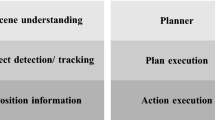Abstract
At the 1992 AAAI robot contest one of the top finishers was Scarecrow—a robot that had no computer in the traditional sense, was built out of less than $200 of parts, and was explained and operated by a five year old. The designers sought to demonstrate the capabilities and competence that can be accomplished by using a strictly reactive architecture for well defined tasks such as that contest. This paper reexamines the Scarecrow robot and puts it into historical context. With fifteen years of perspective, we can also see what Scarecrow has to say about the perception of intelligence.








Similar content being viewed by others
Explore related subjects
Discover the latest articles, news and stories from top researchers in related subjects.Notes
For Scarecrow, obstacle detection and collision detection were one and the same.
Some readers have pointed out that this grouping may not be fair to rats.
i.e., the World itself.
It swaggered due to the flexing of the aluminum plate to which the mast was mounted.
Keep It Simple, Stupid.
Sculpey is a polymer clay that can be hardened in a conventional oven, rather than a kiln.
See Fig. 8.
References
Bonasso, R.P. and Miller, D.P. (eds.), 1993. Fall Symposium on Instantiating Intelligent Agents. AAAI Press.
Braitenberg, V. 1986. Vehicles: Experiments in Synthetic Psychology. MIT Press.
Brooks, R.A. 1986. A robust layered control system for a mobile robot. IEEE Journal on Robotics and Automation, RA-2(1).
Clarke, A.C. 1962. Profiles of the Future. Warner Books, reprint edition (march 1985) edition.
Congdon, C., Huber, M., Kortenkamp, D., Konolige, K., Myers, K., Saffiotti, A., and Ruspin, E. 1993. Carmel versus flakey: A comparison of two winners. AI Magazine, 14(1).
Dawes, R.M., and Hastie, R. 2001. Rational Choice in an Uncertain World: The Psychology of Judgement and Decision Making. Sage Publications.
Hiller, M. 1976. Automata & Mechanical Toys: An Illustrated History. Jupiter, London, England.
Hyman, A. 1985. Charles Babbage: Pioneer of the Computer. Princeton University Press.
iRobot Corporation. 2006. Roomba technology. http://www.irobot.com/sp.cfm?pageid=124.
Kopplin, J. 2002. An illustrated history of computers, part 2. http://www.computersciencelab.com/ComputerHistory/HistoryPt2.htm.
LeGrand, R., Machulis, K., Miller, D.P., Sargent, R., and Wright, A. 2005. The XBC: A modern low-cost mobile robot controller. In Proceedings of IROS 2005. IEEE Press.
Neisser, U. 1982. John dean’s memory: A case study. In Memory Observed: Remembering in Natural Contexts. W.H. Freeman. pp. 139–159.
Okita, S. and Schwartz, D.L. 2006. Young children’s understanding of animacy and entertainment robots. International Journal of Humanoid Robotics, 3.
Sargent, R., Bailey, B., Witty, C., and Wright, A. 1997. Dynamic object capture using fast vision tracking. AI Magazine, 18(1).
Simmons, R.G. 1992. Concurrent planning and execution for autonomous robots. Control Systems Magazine, IEEE, 12(1):46–50.
Stein, C. 2003. Botball: Autonomous students engineering autonomous robots. Computers in Education Journal, 13(2).
Takanashi, S. 2002. Japanese mechanical dolls. http://www.cjn.or.jp/karakuri/takanashi.html.
The Karakuri Corner. 2006. Karakuri automata kits. http://www.karakuricorner.com/servlet/the-Karakuri-Automata-Kits/Catego ries.
Author information
Authors and Affiliations
Corresponding author
Additional information
With apologies to Mssrs. Harburg & Arlen: I could suck up amps of power; Computing for many hours; Making models verify; And my inferences would be seizing; While my memory was GC’ing; If I only had AI.
David P. Miller received his Ph.D. in Computer Science from Yale University in 1985. He is currently the Wilkonson Chair and Professor in the Aerospace and Mechanical Engineering Department at the University of Oklahoma. Miller started the development of small rovers at JPL which led to the Mars Pathfinder Rover mission. He continues research on planetary surface robotics, while also working on assistive and educational robotics. He is widely published in all of these areas. Miller is a founder of, and a technical advisor to, KISS Institute for Practical Robotics where he instructs hundreds of middle and high school teachers on robotics each year. Working closely with Cathryne Stein in 1986, Miller helped to create Jacob Milstein. This project continues to yield interesting results.
Jacob Milstein is the inaugural recipient of the American Association for Artificial Intelligence’s “Making us Stop and Think” robotics award (1992) for his work on Scarecrow. Having conquered the field of robotics at the age of five, he has since moved on to work in other disciplines. He is currently a student at Wesleyan University.
Cathryne Stein is the Executive Director and a Founder of KISS Institute for Practical Robotics, a national, nonprofit educational organization. Under her direction, KISS Institute has developed several national programs, including the Botball Educational Robotics Program for middle and high school students, Beyond Botball for college and the post-high school crowd, Robots in Residence for elementary and middle schools, and the National Conference on Educational Robotics for students, teachers, and professionals. Over 80,000 individuals have been impacted by these programs, which promote active engagement in science, engineering, computer programming, and AI through robotics.
Rights and permissions
About this article
Cite this article
Miller, D.P., Milstein, J.Q. & Stein, C. Scarecrow: If I only had AI. Auton Robot 22, 325–332 (2007). https://doi.org/10.1007/s10514-006-9017-4
Received:
Revised:
Accepted:
Published:
Issue Date:
DOI: https://doi.org/10.1007/s10514-006-9017-4




